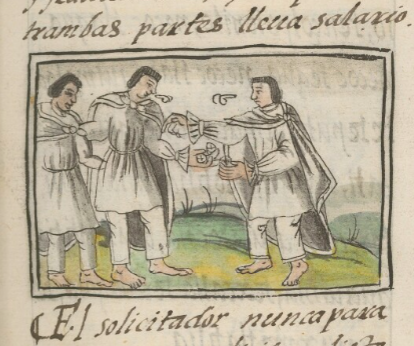peso (FCbk10f22r)
This detail from a painting shows hands exchanging coins, apparently relating to salaries or bribes in a discussion about attorneys. The coins have crosses on them, which suggests pesos rather than tomines. Tomines were eighths of pesos. Sometimes the tomines had dots on them showing one, two or three. A half peso tomin would have the number 4 on it. But pesos had crosses, distinguishing them.
Stephanie Wood
There is no gloss or even a word in the text that mentions pesos, but comparing them to glyphs of coins helps identify them. See examples of both pesos and tomines below. Also worth noting is how tomines were the coins most common in the local Nahua economy, and tomin came to mean “money.” But town councils were accustomed to dealing in larger sums, including pesos.
Stephanie Wood
1577
Jeff Haskett-Wood
moneda, monedas, dinero
peso, a unit of money (a loanword from Spanish), https://nahuatl.wired-humanities.org/content/peso
peso
Stephanie Wood
Available at Digital Florentine Codex/Códice Florentino Digital, edited by Kim N. Richter and Alicia Maria Houtrouw, "Book 10: The People", fol. 22r, Getty Research Institute, 2023. https://florentinecodex.getty.edu/en/book/10/folio/22r?spTexts=&nhTexts= Accessed 23 June 2025.
Images of the digitized Florentine Codex are made available under the following Creative Commons license: CC BY-NC-ND (Attribution-NonCommercial-NoDerivs 4.0 International). For print-publication quality photos, please contact the Biblioteca Medicea Laurenziana ([email protected]). The Library of Congress has also published this manuscript, using the images of the World Digital Library copy. “The Library of Congress is unaware of any copyright or other restrictions in the World Digital Library Collection. Absent any such restrictions, these materials are free to use and reuse.”




